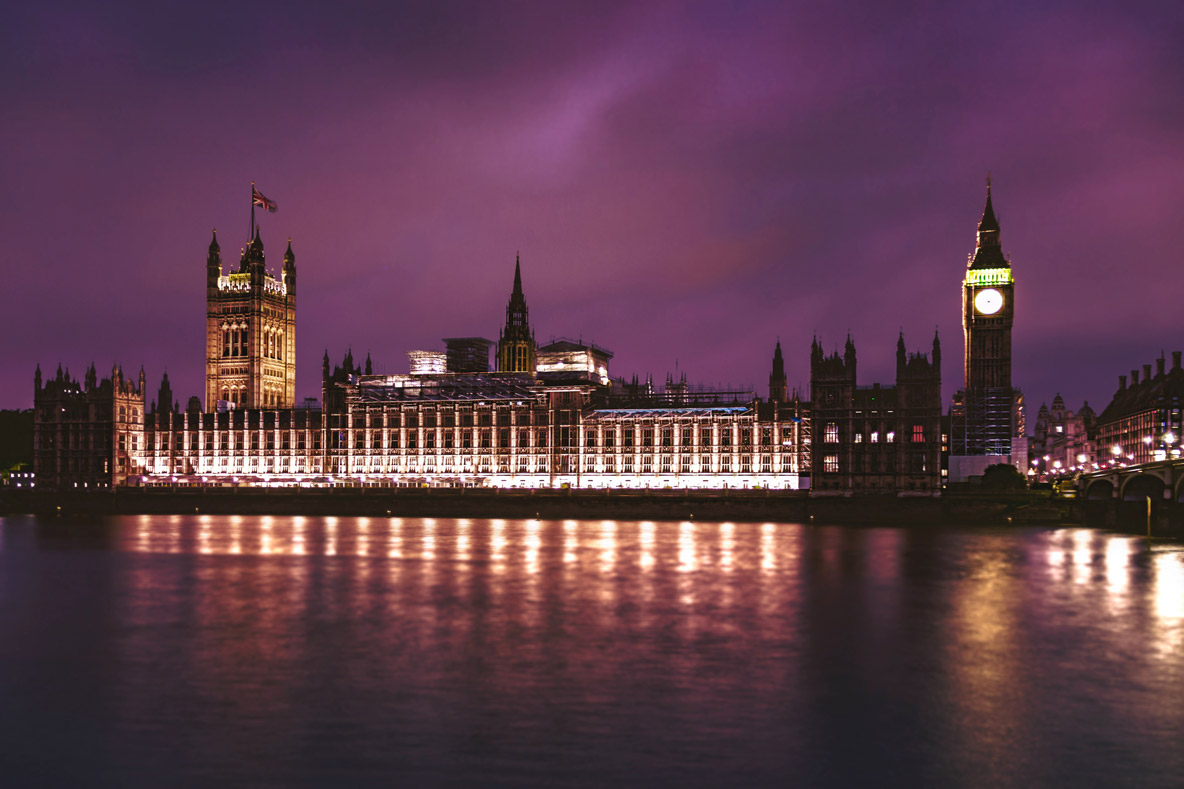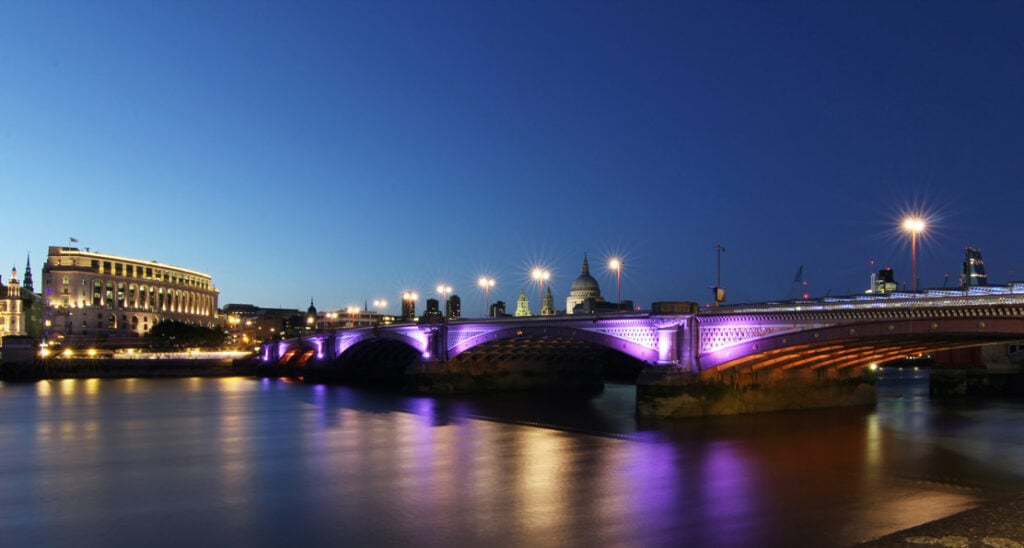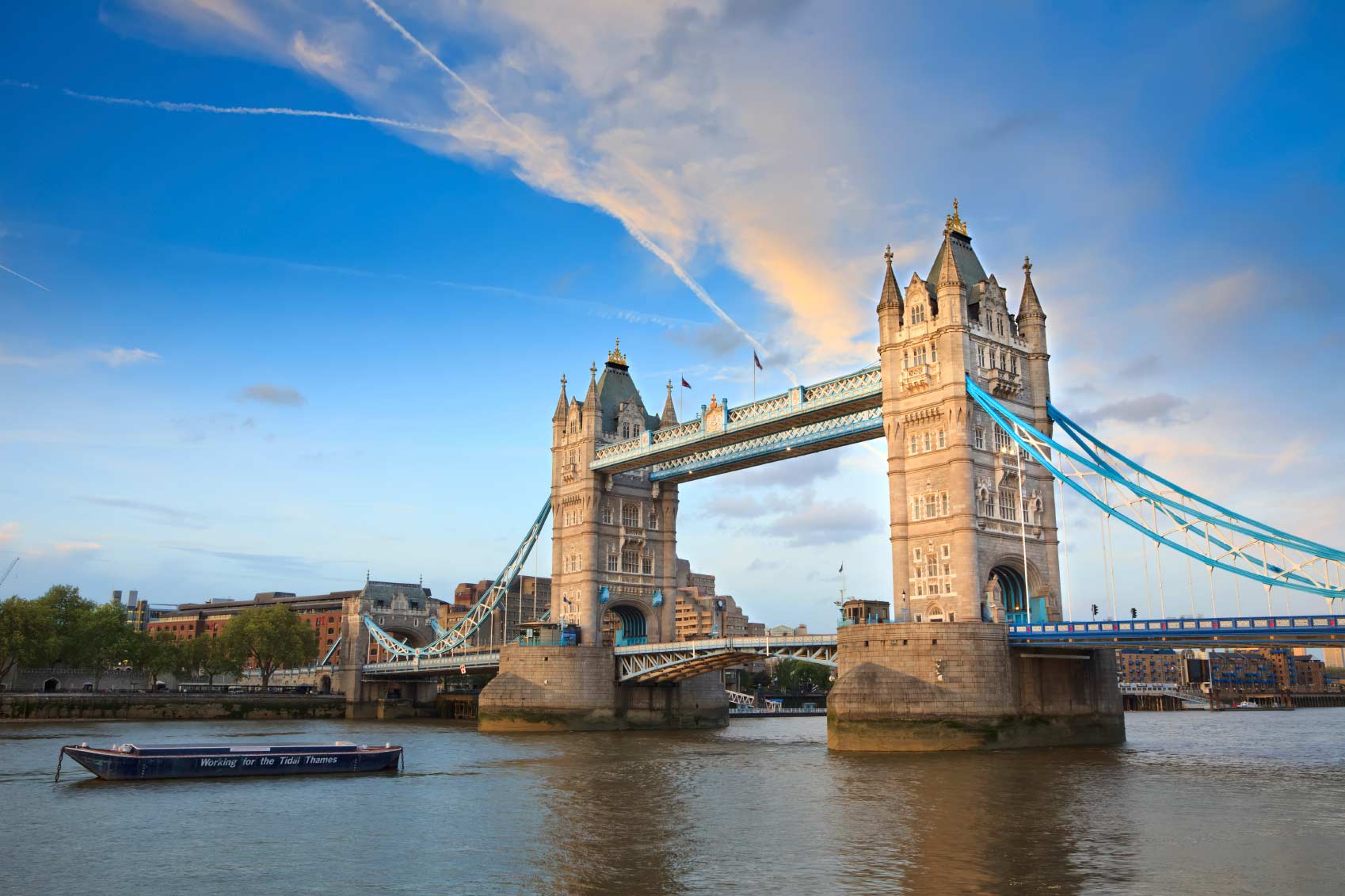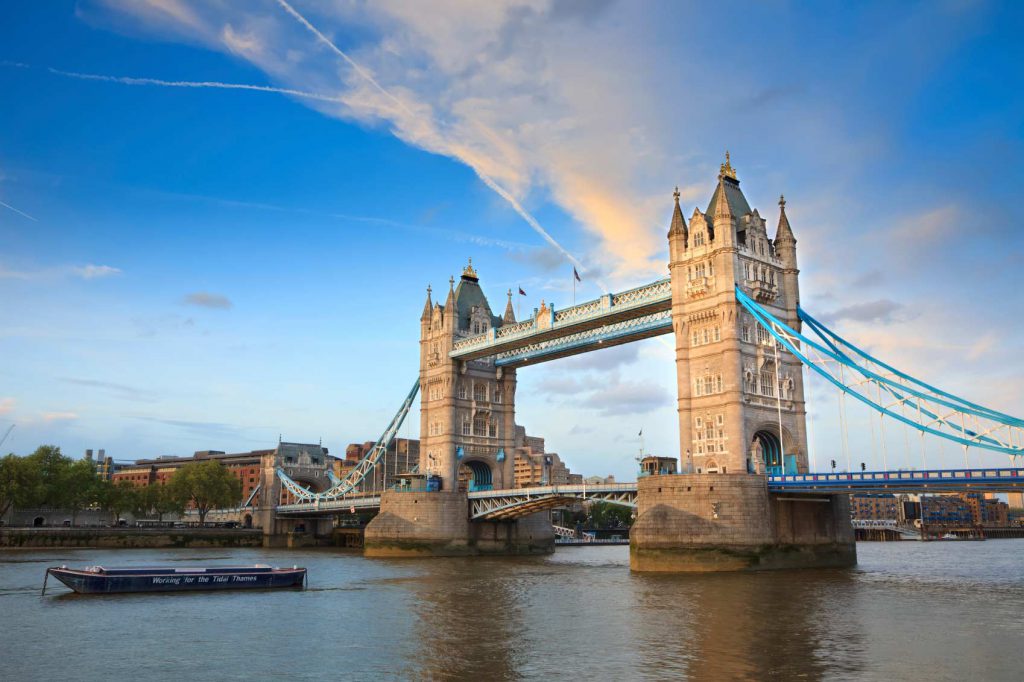London is world-renowned for its beautiful and historical architecture, quintessentially British atmosphere and its patchwork of unique boroughs. Whether you’re exploring its streets by foot, on a red open-top bus, or you’re exploring its plethora of views on an exciting Thames river cruise, there are some real gems that shouldn’t be missed and with City Cruises we take you on a journey of discovery – we have a different view and it’s waiting to be explored!
From 17th century masterpieces to illustrious architectural icons, the capital of the UK boasts some of the world’s most stunning and visually brilliant bridges, all waiting to be explored and uncovered. In this article, we discover some of London’s most famous water landmarks and dive into the archives to uncover the hidden secrets and untold stories of London’s best bridges. Who’s ready to step back in time?
There is no better way to explore these historic and visually brilliant landmarks than on the river and July 2019 saw the first switch-on of Illuminated River, an ambitious public art commission transforming the capital’s central bridges. Every night our guests can see the first four illuminated bridges – Cannon Street, London, Southwark and Millennium Bridge – and by autumn 2020 the bridges from Blackfriars Road Bridge to Lambeth will also be illuminated along the river. The best view of the illuminations is from the river because as you cruise through on a sightseeing or dinner sailing you will see every aspect of the striking artwork.
Illuminated Rivers describe the project as a unique collaboration of London’s talent: “The realisation of the project has involved a unique collaboration of London’s creative talent, statutory bodies and local communities and will leave a lasting legacy for the capital in the form of a dynamic public artwork, refocusing and celebrating the Thames bridges as social, historical and architectural landmarks.”
Let’s find out a little more about the bridges that are a part of this project and how these magnificent structures became the famous icons that link London’s north and south as we see them today, as well as being some of our favourites spots along the river.
Westminster Bridge
Built: Between 1739 and 1750

A view made renowned by its sister property the Houses of Parliament, Westminster Bridge links Westminster on the west to Lambeth on the east side of the water. Known for being one of the oldest surviving bridges in the city, it is also known to locals as being one of the busiest. It was built in an attempt to relieve congestion coming from the west and the south of the city and to accommodate the growing use of the goods and passenger carriages as transport in the Victorian period boomed.
Now a vehicle and pedestrian bridge, it is used by millions of visitors every year and links two of the city’s most iconic symbols to one another; Big Ben and the London Eye. Remodelled in 1862, the current bridge that crosses the river was designed by Thomas Page and boasts a royal seal of approval. As well as its magnificent green colour which mimics those of the seats in the House of Commons, it also hosts the coats of arms of Queen Victoria and Prince Albert on one of its many large stone pillars. Since its opening, the bridge has taken on a number of façades, previously used in the 18th century as a spot for vagabonds and muggers and in the 17th century when it became one of the most painted sights in London. The bridge also now holds a Grade II Listed rating, protecting its structure and position within the city.
A walk along Westminster Bridge will offer you magnificent views of Big Ben and the Houses of Parliament with the London Eye and Sea Life London Aquarium to the east and downstream towards the city centre, a real photography lovers paradise, you’re not going to find a better view of the city than in the middle of this bridge. If you’re lucky, you might even stumble across a street performer or two. Autumn 2020 will also see work start on the Illuminated River installation that’ll include this impressive bridge.
Waterloo Bridge
Built: First built in 1817, rebuilt in 1945
Not as aesthetically pleasing as Westminster Bridge (we’re not biased), but with a story just as impressive. Waterloo Bridge was first built in 1817 with its name emulating the victory at the Battle of Waterloo two years prior in 1815. It was also known for being the longest bridge in London. Due to its courageous name, the local station and surrounding borough were also named Waterloo and remain foundation blocks of the city to this day. At the turn of the century, the use of heavy motor vehicles grew, and the safety of the bridge became uncertain, what ensued was a 10-year political battle took place to remodel the bridge to suit carriages and motor vehicles.
Almost named the Strand Bridge before ‘Waterloo’ was agreed by an Act of Parliament, the old bridge was remodelled and rebuilt in 1945, during the Second World War. Notably nicknamed ‘The Ladies Bridge’ after its rebuild in 1945 due to the large number of female workers who aided the construction whilst the men were off at war. Starting in 1939, the construction of the new bridge was slow and steady, due to the lack of human power and the facilities on offer to those building it.
Since remodelling, the bridge has featured in TV and film alike in shows like Sherlock and Alfie and has become a magnet for those wanting to head to the prestigious areas of Covent Garden in the north and the Southbank Centre in the south. For those planning to visit in 2020, expect to see the distant glow of the Illuminated River project as it takes hold of Waterloo Bridge to be completed in the autumn months.
Blackfriars Bridge
Built: First built in 1769, rebuilt in 1869
Situated between its sister bridge Blackfriars Railway Bridge and Waterloo Bridge, Blackfriars Bridge is a traffic and pedestrian Grade II Listed bridge in the heart of London. Built in 1769, its structure is among the oldest in the city and took some 9 years to build. Named after a Dominican priory which once stood nearby, its name was changed several times before the calling we hear today.
Most well-known for its elaborate stone carvings that line the columns it stands upon, depicting birds and marine life, as well as the statue of Queen Victoria at the north side of the bridge which has stood in the same spot since she opened the new bridge back in 1869.
It is often regarded as one of the prettiest bridges in London due to its red and cream colouring, carefully carved arches and large and imposing columns. It lies alongside the adjacent railway bridge and the remnants of the old Blackfriars Bridge that can be spotted by the columns that still lie in the river to this day. A wander along (or a cruise under) this impressive bridge will give you a sense of scale and a glimpse at the true beauty of this architectural masterpiece.
The railway bridge is set to be a part of the upcoming Illuminated Bridges project, so keep your eyes peeled when you’re next on a river cruise to see the progress of its transformation. The illuminations for the bridge are set to be colourful and creative: “The Illuminated River artwork for Blackfriars Bridge will use a colour scheme that closely complements the adjacent Blackfriars Railway Bridge and the red pillar supports that remain from the original Blackfriars Railway Bridge.”
Millennium Bridge
Built: 2000
 Named after the year it was built at the turn of the millennium, Millennium Bridge is the youngest bridge in this article, yet one of the most striking. Built in 2000 after a competition was held by Southwark Council to commission a new bridge, the proposal pushed all the boundaries in technical design and is now a real landmark in the city.
Named after the year it was built at the turn of the millennium, Millennium Bridge is the youngest bridge in this article, yet one of the most striking. Built in 2000 after a competition was held by Southwark Council to commission a new bridge, the proposal pushed all the boundaries in technical design and is now a real landmark in the city.
Opened by Queen Elizabeth II on the 10th June 2000 the bridge had to be closed two days later, finally reopening again on 27th February 2002, a whole two years later. Its location was chosen due to its proximity to a number of the city’s busiest locations, not to mention the beautiful view of St Pauls Cathedral that can be seen as you walk down the walkway. The Tate Modern lies on the south side of the river as well as the historic Globe Theatre, which stands proudly on the water’s edge.
Something that many people don’t know is that the bridge plays host to over 400 works of art! These tiny works of art were designed and implemented by The Chewing Gum Man, also known as Ben Wilson. Tiny scenes, shapes and figures are painted onto pieces of dropped gum, giving the floor of this bridge a somewhat patchwork feel.
We spoke to Stu who is a London walking blogger at London Wlogger who loves exploring London’s architectural treasures, he told us a little more about Millennium Bridge: “For me London is the greatest city in the world, it encapsulates the old and new perfectly, and has something picturesque wherever you look – whether that’s its landmarks, parks or bridges, you’re never too far from something amazing to explore! One of my favourite bridges in London is its most recent one, Millennium Bridge! Opened in June 2000, did you know it was the first bridge to be built over the Thames for over 100 years?
“One unique aspect of the Millennium Bridge is that it has had two openings, first in 2000 and then again in 2002. On its opening day, the bridge had 80,000 people walk across it and 2,000 on it at any one time. However, on the southern and central part of the bridge people felt it swaying and as a result, the bridge was closed and given the nickname the ‘Wobbly Bridge’. The bridge lasted only two days and it wasn’t until February 2002 that it reopened to the public!”
Head to Millennium Bridge this summer and see the newly illuminated bridge as part of the ongoing project curated by Illuminated River. The Millennium Bridge is one of 4 bridges to be fitted with its new lighting and looks even better in the dark of night.
Southwark Bridge
Built: First built in 1819, rebuilt in 1921

Originally known as Queen Street Bridge, Southwark Bridge was first built in 1819 to support the flow of traffic needing to get to the south of the city. The original bridge was designed by John Rennie and was built out of cast iron and supported by three large pillars secured into the river. The first bridge was demolished during World War 1 due to its narrow road which needed widening because of the growing use of motor vehicles.
The bridge as we see it today was begun in 1912 but didn’t open to the public until after the war in 1921. Due to its historical significance in the city, the new bridge was given Grade II listed status in 1995. Walk along Southwark Bridge to the south and you’ll find the original site of Shakespeare’s Globe, head north and you’ll find the famous London Stone. On the south side, you’ll find a short walk to the Shard and Borough Market. Southwark Bridge is another of the bridges that has seen the dressing of its new lights this year as part of the summer 2019 part of the Illuminated project.
“Drawing inspiration from the colour palettes of the Impressionist masters, the bridge’s illumination will continue, with slightly more saturation, the colours used on Cannon Street Bridge.” Illuminated River reports.
Cannon Street Railway Bridge
Built: Between 1863 and 1866
The path from Cannon Street Railway Station to the expanse of London that lies beyond it, Cannon Street Railway Bridge is owned by the National Rail and has been a hub of activity since it opened in 1866. Sitting pretty between Southwark Bridge and London Bridge, the original structure was designed by Sir John Hawkshaw and has nothing to do with weaponry as its name may suggest. It is actually named after the 17th-century word ‘candelwrichstrete’ which translates today to ‘street of the candlemakers’.
Since its refurbishment in 1982, many of its previous decorative features have been removed and replaced by cast-iron pillars, but two brick towers from the original bridge can still be seen on the riverfront. If you’re planning to jump on a city river cruise, be sure to look out for this vast bridge and its brand new illuminations added to the structure recently in summer 2019, a real mark in the history books.
Illuminated River describes its new fittings as a celebration of the character of the bridge: “Cannon Street Bridge, despite being one of the oldest bridges on the Thames, has never been lit before. Villareal’s artwork will celebrate the bridge’s oft-overlooked utilitarian character and monumental Doric columns, with subtle kinetic colours mirroring the motion of the trains passing above.”
London Bridge
Built: 1973
Not to be confused with Tower Bridge, London Bridge is one of London’s oldest bridges with the structure standing on the site since the Roman period. There has been a number of different facades, but the current bridge was completed in 1973 with the preceding bridge being dismantled after 600 years of service.
London Bridge has been notable for plenty of news and scandals over the years, with heads of traitors to the crown being staked along its walls during the Tudor period as well as being the subject for a number of nursery rhymes over the years. In 1722, the previous bridge became too crowded so a ‘keep left’ rule was implemented, which later became the common pattern for roads across the whole of the UK. If you want to see the bridge take on a less formal side, head down the river during the annual Sheep Drive. Hosted by the City of London every autumn, traffic comes to standstill and hundreds of sheep are herded by Freemen across the bridge, a practice that dates back to the 1200s.
London Bridge is another of the summer installations as part of the Illuminated River project and one that cruisers of the river can already see in all its glory. A subtle hue of pinks and oranges can be seen as you pass under its impressive concrete pillars.
Tower Bridge
Built: Between 1886 and 1894
 Of course, we saved the best till last. One of the most iconic landmarks in London and one of the best Victorian built bridges in the world. A real architects dream, Tower Bridge is visited by millions every year who are looking for a glimpse at the magnificent architecture that makes this bridge so fascinating. Built between 1886 and 1894 Tower Bridge is one of few surviving original suspension bridges in the city and opens to passing boats more than 1000 times a year, taking 61 seconds to raise its arms fully.
Of course, we saved the best till last. One of the most iconic landmarks in London and one of the best Victorian built bridges in the world. A real architects dream, Tower Bridge is visited by millions every year who are looking for a glimpse at the magnificent architecture that makes this bridge so fascinating. Built between 1886 and 1894 Tower Bridge is one of few surviving original suspension bridges in the city and opens to passing boats more than 1000 times a year, taking 61 seconds to raise its arms fully.
Many people visiting the bridge may not know that water traffic gets priority over road traffic, so a walk over the river may take a little longer than usual. Pedestrians previously used the high walkways above the lifting arms to avoid any delays until its closure in 1910 due to a lack of use, but visitors to the bridge today can experience these high-level open-air walkways in a totally different way.
“Your experience will start inside the bridge itself and is the most exciting way to explore the most famous bridge in the world, from the spectacular new glass floors on its high-level walkways (though you don’t have to look), to the historic Engine Rooms and towers.”
Many people confuse the bridge with London Bridge, which is actually a different bridge a little further down the river, and rather less impressive. There were over 50 different designs put forward for the bridge, but the one we see today was designed by Sir Horace Jones. The bridge has seen a number of makeovers since its opening, it was originally painted a dark brown colour, in 1977 it was painted red, white and blue to commemorate the Queen’s Silver Jubilee and it now sits pretty in a grey and blue hue.
A visit to London wouldn’t be complete without a visit to at least one of these magnificent structures and the chance to experience a taste of the real London. If you want to experience the Thames in real style, join us on one of our upcoming Thames cruises and see these stunning structures from a whole new perspective. We offer more than just sightseeing trips, we offer a spacious outdoor top deck, tasteful food and above all, spectacular views from a whole new perspective.


